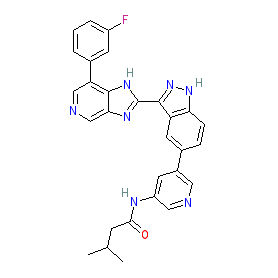GtoPdb is requesting financial support from commercial users. Please see our sustainability page for more information.
|
Synonyms: adavivint (deprecated INN) | SM0-4690 | SM04690
Compound class:
Synthetic organic
Comment: Lorecivivint (SM04690, formerly adavivint) is a Wnt pathway inhibitor being developed by Samumed for immunomodulatory potential. It acts downstream of β-catenin, and its molecular targets are the intranuclear kinases CLK2 and DYRK1A through which it inhibits phosphorylation of serine/arginine-rich splicing factors, and SIRT1 and FOXO1 respectively [3]. Wnt signalling is upregulated in tissues from osteoarthritic joints, and drives disease pathologies including inflammation [5]. Wnt pathway inhibition by lorecivivint is being investigated as a disease-modifying treatment for osteoarthritis.
SM04690 is example 10 as claimed in patent US20160297812 [4]. The chemical structure shown here was produced using the IUPAC name submitted to the WHO for the INN adavivint (via SMILES generated using Chemicalize) which was later renamed as lorecivivint. This SMILES string resolves to PubChem CID 123710737, although some of the double bonds in the molecule are not fully resolved, when compared to the images in US20160297812. CID 89837869 is an alternative representation. Ligand Activity Visualisation ChartsThese are box plot that provide a unique visualisation, summarising all the activity data for a ligand taken from ChEMBL and GtoPdb across multiple targets and species. Click on a plot to see the median, interquartile range, low and high data points. A value of zero indicates that no data are available. A separate chart is created for each target, and where possible the algorithm tries to merge ChEMBL and GtoPdb targets by matching them on name and UniProt accession, for each available species. However, please note that inconsistency in naming of targets may lead to data for the same target being reported across multiple charts. ✖ |
|
|||||||||||||||||||||||||||||||||||
| References |
|
1. Blom AB, Brockbank SM, van Lent PL, van Beuningen HM, Geurts J, Takahashi N, van der Kraan PM, van de Loo FA, Schreurs BW, Clements K et al.. (2009)
Involvement of the Wnt signaling pathway in experimental and human osteoarthritis: prominent role of Wnt-induced signaling protein 1. Arthritis Rheum, 60 (2): 501-12. [PMID:19180479] |
|
2. Deshmukh V, Hu H, Barroga C, Bossard C, Kc S, Dellamary L, Stewart J, Chiu K, Ibanez M, Pedraza M et al.. (2018)
A small-molecule inhibitor of the Wnt pathway (SM04690) as a potential disease modifying agent for the treatment of osteoarthritis of the knee. Osteoarthr Cartil, 26 (1): 18-27. [PMID:28888902] |
|
3. Deshmukh V, O'Green AL, Bossard C, Seo T, Lamangan L, Ibanez M, Ghias A, Lai C, Do L, Cho S et al.. (2019)
Modulation of the Wnt pathway through inhibition of CLK2 and DYRK1A by lorecivivint as a novel, potentially disease-modifying approach for knee osteoarthritis treatment. Osteoarthr Cartil, 27 (9): 1347-1360. [PMID:31132406] |
|
4. Hood J, Wallace DM, Kumar S. (2016)
INDAZOLE INHIBITORS OF THE WNT SIGNAL PATHWAY AND THERAPEUTIC USES THEREOF. Patent number: US20160297812. Assignee: Samumed LLC. Priority date: 04/04/2012. Publication date: 13/10/2016. |
|
5. Luyten FP, Tylzanowski P, Lories RJ. (2009)
Wnt signaling and osteoarthritis. Bone, 44: 522-527. DOI: 10.1016/j.bone.2008.12.006 |
|
6. Maeda A, Ono M, Holmbeck K, Li L, Kilts TM, Kram V, Noonan ML, Yoshioka Y, McNerny EM, Tantillo MA et al.. (2015)
WNT1-induced Secreted Protein-1 (WISP1), a Novel Regulator of Bone Turnover and Wnt Signaling. J Biol Chem, 290 (22): 14004-18. [PMID:25864198] |
|
7. Yates KE, Shortkroff S, Reish RG. (2005)
Wnt influence on chondrocyte differentiation and cartilage function. DNA Cell Biol, 24 (7): 446-57. [PMID:16008513] |
|
8. Yazici Y, McAlindon TE, Fleischmann R, Gibofsky A, Lane NE, Kivitz AJ, Skrepnik N, Armas E, Swearingen CJ, DiFrancesco A et al.. (2017)
A novel Wnt pathway inhibitor, SM04690, for the treatment of moderate to severe osteoarthritis of the knee: results of a 24-week, randomized, controlled, phase 1 study. Osteoarthr Cartil, 25 (10): 1598-1606. [PMID:28711582] |








